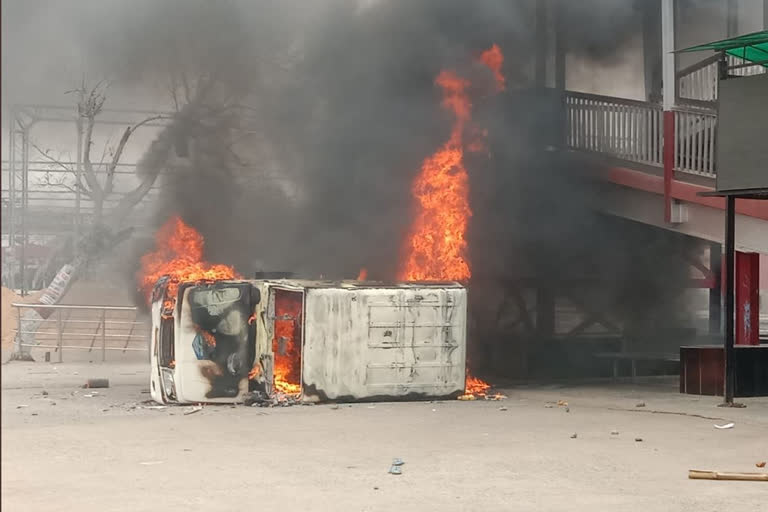New Delhi: It is said that the Indian soldier is but a peasant in uniform. Nothing underlines it more than the ongoing widespread and often violent protests by youths with farming backgrounds from across many states in the country. Already, on Monday (June 20), the Samyukta Kisan Morcha (SKM), an umbrella organization of Indian farmers, has called for a nationwide ‘bandh’ on June 24 in protest against the ‘Agnipath’ military recruitment scheme for the non-officer ranks in the three services of the Armed Forces—the army, the navy and the air force.
A leading expert on agriculture and food policy Devinder Sharma said: “There is a direct linkage between agricultural workers who are in distress and the ongoing protests. Look at the anger spilling out on the streets. This is a reflection of affairs in the rural swaths.” Sharma says that according to the 2016 Economic Survey, the average income of a farming family in 17 states of India was just Rs 20,000 a year.
“That is roughly half of the country. If the farmer is earning less than Rs 1,700 a month, why would his descendants take to farming? What do you expect them to do? Obviously, the youth would look for greener pastures,” asks Sharma.
“We have denied the farmers the rightful income all these years. That is the main reason. We have deliberately kept agriculture impoverished. It is a deliberate ploy because that is how economic reforms in India have become viable. You have to sacrifice agriculture to finance the industry.”
Announced on June 14, the ‘Agnipath’ scheme recruits youths aged between 17.5 to 21 years (with a one-time extension of the upper age limit to 23 years) for a period of 4 years, upon completion of which, one-fourth or 25% of the ‘Agniveers’ will be re-employed for 15 more years based on merit, their intent and the organizational requirement. The remaining three-fourths or 75% would be adequately compensated with an attractive retirement package called ‘Seva Nidhi’.
What ‘Agnipath’ aims to do is to harness the peak fitness and dynamism of the youth aged between 17.5 to 21 years, and shave off the average age profile of the Indian soldier by 6 years from 32 to 26 years.
On Tuesday (June 21), Lt Gen Anil Puri, additional secretary in the Department of Military Affairs (DMA), called the ‘Agnipath’ scheme “security-centric, youth-centric and soldier-centric.” While the military establishment on Sunday (June 19) blamed vested interests like “inimical elements” and “coaching centres”, the linkage with the acute distress in the Indian agricultural sector is telling.
The protests which have led to wanton acts of arson, vandalism, widespread destruction of public property and disruption of day-to-day life have largely emanated from the mofussil towns and the vast rural swaths of Bihar, Uttar Pradesh, Jharkhand, Odisha, Telangana, Madhya Pradesh, West Bengal, Andhra Pradesh, Maharashtra, etc where the farm sector is in acute distress.
Also read: Protests should be peaceful: Pankaj Tripathi on 'Agnipath' demonstrations
Says Kumar Sanjay Singh, an analyst who teaches history in a Delhi University college: “The protests are a clear case of spillover of agrarian distress leading to a surplus population amid acute lack of gainful job opportunities. The areas of protest are areas of massive surplus agrarian population. Here a military career provides a very important avenue for employment partly because of the prestige aspect and also because of the pecuniary benefits that soldiers get.”
“Moreover, while agrarian prices have not kept pace with industrial prices, the cost of production in agriculture has also increased because of the ‘Green Revolution’-based approach with rising input costs on things like fertilizers, pesticides and high yielding variety seeds,” Singh adds.
According to the National Statistical Office (NSO) findings released in September 2021 after its 77th round of the survey, the per capita monthly income of a farming household in the country is Rs 10,218. While the average monthly income of a farmer in Bihar was the country’s lowest at Rs 3,558 per month per farming household, West Bengal followed with Rs 3,980, Uttarakhand with Rs 4,701, Jharkhand with Rs 4,721, Uttar Pradesh with Rs 4,923 and Odisha with Rs 4,976.
On the other hand, Haryana had the highest farmer’s monthly average income at Rs 14,434. The survey also found that more than 50% of agricultural households were in debt with an average amount of Rs 74,121 of the outstanding loans per agricultural household.
In a consumption expenditure survey for 2011-12, the National Sample Survey Office (NSSO) data revealed that more than 20% of farming households in rural areas were having income less than the poverty line. The states with huge farming populations with incomes below the poverty line included Jharkhand (45%), Odisha (32%), Bihar (28%), Madhya Pradesh (27%) and Uttar Pradesh (23%).
Interestingly these are the states that have seen the most vocal protests against the ‘Agnipath’ scheme. These are also the states where the fragmentation of land holdings has hit the agricultural community the most.
That is also the reason why Punjab and Haryana—two of the most prosperous states—have seen muted protests despite sending the most number of recruits to the military. In addition, “chakbandi” or the process in which land is consolidated to prevent further fragmentation has been quite effective in Punjab and Haryana. This is in contrast to the massive land fragmentation of farm holdings that has happened in eastern Uttar Pradesh and Bihar—the focal areas of anti ‘Agnipath’ protests.
While Haryana had 4% of its farming population below the poverty line, in the case of Punjab, it was a mere 0.5%. This is besides the fact that joining the military no longer is the prime attraction for the youth of Punjab which has now been replaced by the desire to migrate either to Canada or Australia.
In the three years from 2018-2020, the top six states from where the recruitment to the non-officer ranks of the three services has taken place are Uttar Pradesh (32,901), Haryana (18,457), Punjab (18,264), Maharashtra (14,180) and Bihar (12,459).


